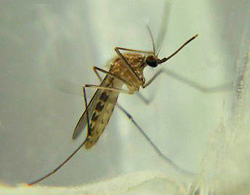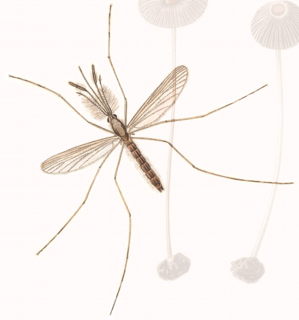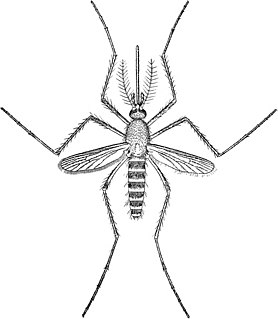Related Research Articles

A mosquito is any member of a group of about 3,500 species of small insects belonging to the order Diptera (flies). Within Diptera, mosquitoes constitute the family Culicidae. The word "mosquito" is Spanish and Portuguese for "little fly". Mosquitoes have a slender segmented body, one pair of wings, one pair of halteres, three pairs of long hair-like legs, and elongated mouthparts.

Sir Ronald Ross was a British medical doctor who received the Nobel Prize for Physiology or Medicine in 1902 for his work on the transmission of malaria, becoming the first British Nobel laureate, and the first born outside Europe. His discovery of the malarial parasite in the gastrointestinal tract of a mosquito in 1897 proved that malaria was transmitted by mosquitoes, and laid the foundation for the method of combating the disease. He was a polymath, writing a number of poems, published several novels, and composed songs. He was also an amateur artist and natural mathematician. He worked in the Indian Medical Service for 25 years. It was during his service that he made the groundbreaking medical discovery. After resigning from his service in India, he joined the faculty of Liverpool School of Tropical Medicine, and continued as Professor and Chairman of Tropical Medicine of the institute for 10 years. In 1926 he became Director-in-Chief of the Ross Institute and Hospital for Tropical Diseases, which was established in honour of his works. He remained there until his death.

Plasmodium is a genus of unicellular eukaryotes that are obligate parasites of vertebrates and insects. The life cycles of Plasmodium species involve development in a blood-feeding insect host which then injects parasites into a vertebrate host during a blood meal. Parasites grow within a vertebrate body tissue before entering the bloodstream to infect red blood cells. The ensuing destruction of host red blood cells can result in disease, called malaria. During this infection, some parasites are picked up by a blood-feeding insect, continuing the life cycle.

Microsporidia are a group of spore-forming unicellular parasites. They were once considered protozoans or protists, but are now known to be fungi, or a sister group to fungi. They have recently been discovered to infect on Coleoptera a large scale, in a 2017 Cornell study. Loosely 1500 of the probably more than one million species are named. Microsporidia are restricted to animal hosts, and all major groups of animals host microsporidia. Most infect insects, but they are also responsible for common diseases of crustaceans and fish. The named species of microsporidia usually infect one host species or a group of closely related taxa. Approximately 10 percent of the species are parasites of vertebrates —several species, most of which are opportunistic, can infect humans, in whom they can cause microsporidiosis.

Culex is a genus of mosquitoes, several species of which serve as vectors of one or more important diseases of birds, humans, and other animals. The diseases they vector include arbovirus infections such as West Nile virus, Japanese encephalitis, or St. Louis encephalitis, but also filariasis and avian malaria. They occur worldwide except for the extreme northern parts of the temperate zone, and are the most common form of mosquito encountered in some major U.S. cities, such as Los Angeles.

The discipline of medical entomology, or public health entomology, and also veterinary entomology is focused upon insects and arthropods that impact human health. Veterinary entomology is included in this category, because many animal diseases can "jump species" and become a human health threat, for example, bovine encephalitis. Medical entomology also includes scientific research on the behavior, ecology, and epidemiology of arthropod disease vectors, and involves a tremendous outreach to the public, including local and state officials and other stake holders in the interest of public safety. Medical Entomologists are employed by private and public universities, private industries, and federal, state, and local government agencies, including all three branches of the US military - who hire medical entomologists to protect the troops from infectious diseases that can be transmitted by arthropods. Historically, during wars, more people have died due to insect-transmitted diseases, than to all the battle injuries combined.

Anopheles claviger is a mosquito species found in Palearctic realm covering Europe, North Africa, northern Arabian Peninsula, and northern Asia. It is responsible for transmitting malaria in some of these regions. The mosquito is made up of a species complex consisting of An. claviger sensu stricto and An. petragnani Del Vecchio. An. petragnani is found only in western Mediterranean region, and is reported to bite only animals, hence, it is not involved in human malaria.
Cyrtotrachelus elegans is a beetle species belonging to the genus Cyrtotrachelus. It is found in the Philippines.

Dorymyrmex elegans is a species of ant in the genus Dorymyrmex. Described by Trager in 1988, the species is endemic to the United States and Mexico, where it is a nocturnal species and is normally seen on cool days.

Thorselliaceae is a family of bacteria belonging to the class Gammaproteobacteria and it was first described in February 2015. It is not assigned to an order. The family consists of four species in two genera. The bacteria are Gram-negative and rod shaped, approximately 1 μm wide and 2 μm long. They are facultative anaerobes and motile. Thorselliaceae bacteria have been found around the world associated with vector mosquitoes, mainly with vectors of malaria.
Francisco E. Baisas was a Philippine entomologist regarded as the "Dean of Philippine Culicidologists" whose "contributions to the knowledge of Philippine mosquitoes is without measure". His passing was described as the end of "an era which saw the elucidation of the malaria vectors of the Philippines and great progress made in the control of a disease which had accounted for as many as 2,000,000 cases annually in those islands."
Euparyphus elegans is a species of soldier flies in the tribe Oxycerini. It is found in Mexico.
Calopotosia is a genus of flower chafers, scarab beetles in the subfamily Cetoniinae. Species are found in Asia.
Protaetia elegans is a species of flower chafers, scarab beetles in the subfamily Cetoniinae. It is found in Taiwan.
Orthonevra elegans is a species of small hoverflies in the subfamily Eristalinae. It is found in Europe and Asia.
Culex (Lutzia) fuscanus is a species of mosquito belonging to the genus Culex. It is found in China, India, Indonesia and Sri Lanka They are natural predators of disease causing mosquito larva such as Aedes aegypti, Anopheles subpictus, and Culex tritaeniorhynchus.
Culex (Culex) mimulus is a species of mosquito belonging to the genus Culex. It is found in Australia, Bangladesh, Cambodia, China, Hong Kong, India, Indonesia, Malaysia, Myanmar, Nepal, New Guinea (Island); Papua New Guinea, Pakistan, Philippines, Singapore, Sri Lanka, Thailand, Taiwan and Vietnam. Larvae can be found from agro wells and adults are malaria vectors.
Cleopus elegans is a species of true weevils in the subfamily Curculioninae. It was first described in Volla, Italy.

Culex territans is a species of mosquito in the family Culicidae.
References
- ↑ Notizie preventive sulle zanzare Italiane. V. Nota preventiva (1) Descrizione di una specie nuova. Zanzara elegante, Culex elegans, n. sp. Ficalbi, Eugenio (1889), Bullettino della Società Entomologica Italiana. XXI, pages 95–100
- ↑ MacDonald, I (1899). "Mosquitos in Relation to Malaria". British Medical Journal. 2 (2020): 699. doi:10.1136/bmj.2.2020.699. PMC 2412234 . PMID 20758666.